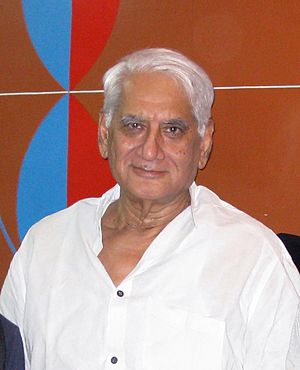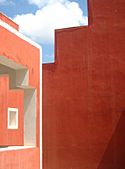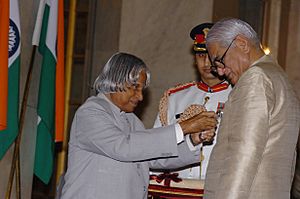Charles Correa facts for kids
Quick facts for kids
Charles Correa
|
|
|---|---|

Correa in December 2011
|
|
| Born |
Charles Mark Correa
1 September 1930 |
| Died | 16 June 2015 (aged 84) Mumbai, Maharashtra India
|
| Alma mater | University of Mumbai Massachusetts Institute of Technology University of Michigan |
| Occupation |
|
| Spouse(s) |
Monika Correa
(m. 1961) |
| Children | 2 |
| Buildings | Jawahar Kala Kendra, National Crafts Museum, Bharat Bhavan |
Charles Mark Correa (born September 1, 1930 – died June 16, 2015) was a very important Indian architect and city planner. He is known for creating modern buildings in India after it became independent. People admired him because he cared about the needs of poor people in cities. He also used traditional building methods and materials in his designs.
Contents
Biography
Early Life and Education
Charles Correa was born in Secunderabad on September 1, 1930. He started his studies at St. Xavier's College, Mumbai. Later, he went to the University of Michigan from 1949 to 1953. He also studied at the Massachusetts Institute of Technology (MIT) from 1953 to 1955. There, he earned his master's degree.
Building a Career
In 1958, Charles Correa started his own architecture business in Mumbai. One of his first big projects was the Mahatma Gandhi Memorial in Ahmedabad (1958–1963). He also designed the Madhya Pradesh Legislative Assembly building in Bhopal (1967).
From 1961 to 1966, he designed his first tall building, the Sonmarg apartments in Mumbai. For the National Crafts Museum in New Delhi (1975–1990), he used a special design idea. He created "rooms open to the sky" by using many courtyards. In the Jawahar Kala Kendra (Jawahar Arts Centre) in Jaipur (1986–1992), his design honored an old ruler named Jai Singh II. He also worked with a British artist, Howard Hodgkin, on the outside design of the British Council building in Delhi (1987–1992).
City Planning and Helping Communities
From 1970 to 1975, Charles Correa was the main architect for Navi Mumbai, also called New Bombay. He played a big part in planning this new city. In 1984, he started the Urban Design Research Institute in Mumbai. This institute works to protect old buildings and improve city communities.
For the last 40 years of his life, Correa did important work on city problems. He also focused on creating affordable homes for people in developing countries. In 1985, the Prime Minister of India, Rajiv Gandhi, made him the head of the National Commission on Urbanization.
From 2005 to 2008, Correa was the Chairman of the Delhi Urban Arts Commission. He also designed the new Ismaili Centre in Toronto, Canada. Another of his designs was the Champalimaud Foundation Centre in Lisbon, Portugal, which opened in 2010.
Later Years
Charles Correa passed away on June 16, 2015, in Mumbai. He had been ill for a short time.
Architectural Work
Correa's Style
Charles Correa designed nearly 100 buildings across India. These ranged from homes for people with low incomes to fancy apartments. He did not like the glass and steel look of some modern buildings. Instead, he focused on designs that fit well with local cultures. He also used traditional materials. His creative designs still offered modern building solutions. His style often brought back outdoor spaces and terraces into buildings.
In 2013, the Royal Institute of British Architects held a special show about his work. It was called "Charles Correa – India's Greatest Architect." The exhibition showed how much his work influenced modern Indian city architecture.
Key Projects
Here are some of the important buildings Charles Correa designed:
| Photo | Date | Name | Location | Notes |
|---|---|---|---|---|
 |
1958–63 | Mahatma Gandhi Sangrahalaya Mahatma Gandhi Memorial |
Sabarmati Ashram, Ahmedabad | |
| 1961–66 | Sonmarg apartments | Mumbai | ||
 |
1967 | Madhya Pradesh Legislative Assembly | Bhopal | |
 |
1969–74 | Kovalam Beach Resort | Kovalam | Its sloped design blends into the landscape. |
 |
1970 | Kala Academy | Panaji | |
 |
1975–90 | National Crafts Museum | New Delhi | |
 |
1982 | Bharat Bhavan | Bhopal | |
 |
1986–92 | Jawahar Kala Kendra Jawahar Arts Centre |
Jaipur | |
 |
1986 | Jeevan Bharati Life Insurance Corporation of India |
Listed as a cultural site at risk in 2018. | |
 |
1987–92 | British Council | Delhi | |
 |
1989 | Jawaharlal Nehru Centre for Advanced Scientific Research | Bangalore | |
 |
2000 | St. Peter and St. Paul's Church, Parumala | Parumala, Thiruvalla | |
 |
2000–05 | McGovern Institute for Brain Research | MIT, Boston, US | |
 |
2007–10 | Champalimaud Centre for The Unknown | Lisbon, Portugal | |
 |
Ismaili Centre | Toronto, Canada |
Awards and Recognition
Charles Correa received many important awards for his work:
- 1972: Padma Shri
- 1984: Royal Gold Medal for architecture from the Royal Institute of British Architects.
- 1994: Praemium Imperiale
- 1998: 7th Aga Khan Award for Architecture for the Madhya Pradesh Legislative Assembly building.
- 2005: Austrian Decoration for Science and Art
- 2006: Padma Vibhushan from the Government of India.
- 2011: Gomant Vibhushan from the Government of Goa.
Personal Life
Charles Correa married Monika Sequeira, who is an artist, in 1961. They lived in one of the Sonmarg apartments in Mumbai, which Charles had designed. They had two children together.
See also
 In Spanish: Charles Correa para niños
In Spanish: Charles Correa para niños
- Geoffrey Bawa
- Muzharul Islam
- B.V. Doshi
- Raj Rewal
- Bashirul Haq


